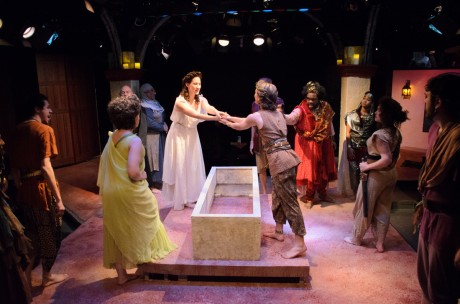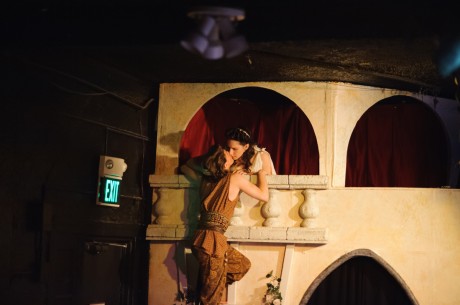The tale of star-crossed lovers, thwarted by fate before their stories even began; the Bard’s oldest and most tragic love tale. We’ve seen it all before, we’ve heard it all before, but The Audrey Herman Spotlighters Theatre is bringing us Romeo & Juliet with a new take on the Shakespearean classic drawing us into the story and making us love and cry all over again. Directed by Lance Bankerd, this production keeps the integrity of the text while transporting the setting to Ancient Greece; a romantically enigmatic location for bloody brawls forbidden romance that taints the civility of the Montague and Capulet households.

The Cast of ‘Romeo & Juliet.’ Photo by Chris Aldridge Photography.
Set Designer Alan Zemla creates the warm open-air feel of the agora with the sandstone columns and painted clay-cracked floor (subtly layering in spatters of red for the final bloody battle in Capulet’s tomb). The iconic balcony is strewn with ivy across its trellis while a far wall depicts a window overlooking the Mediterranean sea; a breezy glance at the Greek Isles all inside the theatre-in-the-round space. The most ingenuous work in Zemla’s design is the pop-out cell for Friar Lawrence and the transformable trough on the platform center stage, serving as a fountain, Juliet’s bed, and finally her tomb.
Every minutia down to the bare feet and bands of gold worn on their right ankles for the Montague men has been outlined to fit the fashions of Ancient Greece by the House of Bankerd, Costume Designers Marie and Richard Bankerd. The costumes are simply divine and truly capture the essence of the time period; long flowing gauzy tunics for Juliet and her mother, a swaddling effect for the Nurse’s costume, and militant patterns for those that spark quarrel in the streets. The Bankerds take the look of the show one step further by designing the hair and wigs, giving the ladies stacks of Grecian curls woven with circlets and other simple yet elegant adornments, even the rogue Tybalt has her hair stacked up in curls like a warrior possessed.
Rounding out the Grecian experience are Lighting Designer Fuzz Roark and Sound Designer Heiko Spieker’s sound effects. Roark and Spieker pipe the theatre full of ambient island light and William Georg’s music that creates a mysterious yet enchanting feel. Georg’s soundtrack for the show includes a live percussionist, with Georg, playing intriguing melodies on the xylophone and adding racing bass pulses to intense scenes. Georg underscores Juliet’s appearances and departures with a wisp of chimes and highlights every kiss she shares with Romeo with a tinkling of bells. This creates a sharp contrast to other sounds featured throughout the production designed to inspire moments of tension and anticipation throughout the audience.
Director Lance Bankerd makes unusual but compelling casting choices when it comes to this production. Melding the characters of Lady and Lord Montague as well as Lady and Lord Capulet into one person each and still keeping the majority of the dialogue for both houses is an unusual choice but a well executed one. It creates a depth in Lady Capulet (playing both the furious father and sympathetic mother in the scene where Juliet rebukes Paris). Bankerd’s choice to make Tybalt and Balthazar female also feel fitting, especially when Tybalt unleashes her rogue personality onto the stage. But Bankerd’s choice of casting Paris as a woman and then referring to her as a woman throughout feels out of place. It creates an unexplained layer of complication in Juliet’s rejection and adds political controversy that feels otherwise out of place. If there was an overarching concept or reasoning behind the all women Capulet casting and all male Montague casting it was not clear and needed to be developed further to translate well upon the stage.
Bankerd has a keen understanding of blocking in the round, utilizing not only every outward facing space, but finding ways to exercise each characters’ individual energy into their movements about the stage. This makes for an engaging production where the actors’ actions speak as loudly as their words and keeps the audience enthralled with the timeless production that is often considered overdone. The one thing that could stand to make the performance stronger is tightening up the scene changes. Granted Bankerd’s cast is moving enormous platforms to create furniture in the center of the stage, and doing so in a very tight space, however the pace at which these shifts occur is agonizing and throws a shuddering halt into the overall movement of the show. These long changes also happen even when furniture isn’t being moved.
An epic portion of Romeo & Juliet is the fighting; brawls and sword bashes breaking out in the streets despite the Prince’s decree against violence. Fight Choreographer Tegan Williams does her best to make these fights look authentic. The hand-to-hand combat, occurring in the beginning during the iconic “thumb-biting speech” is well executed, but the majority of the fighting, which is done with swords, feels hesitant and moves slowly as if the actors are counting their paces, stepping and then thrusting. Williams’ fight work does improve as the play progresses, however, so that by the final sword fight between Paris and Romeo it looks much more convincing.
The acting in the production all around is sublime; these actors of varying ages having a rich understanding of Shakespeare’s text, knowing how to translate that text into emotion and bring meaning to their words through facial expressions, body language, intonation, and action. Tybalt (Lee Conderacci) is a ferocious warrior with a loose cannon temper. Conderacci’s tongue can no more be quelled than her anger can, even when Lady Capulet puts her in her place at the dinner party. She is an explosion waiting to happen, even more frightening as a woman than the character which is traditionally male. Melanie Glickman takes on the task of developing three distinctive male-turned-female characters: Balthazar, Paris, and the Apothecary, and does an exceptional job of keeping them separate from one another. Watch closely for Glickman’s infusion of terror into Balthazar in the opening brawl; a unique and bold choice that separates her performance from the others.
The Nurse (Nicole Mullins) provides a great deal of comic relief in this woeful tragedy. She unearths little moments of humor and plays them up fully, earning subtle chuckles from the audience. Mullins enriches the role with little gestures, particularly when addressing Juliet, and finds the nuances crafted into the character, making her more than just a supporting character in this performance. The flirtatious scene she shares with Mercutio is a rather dynamic change to how this scene is usually interpreted, just one of several instances where Mullins defines the character as her own.
The saucy Mercutio (Adrian Graham-Chesnavage) is played out in this performance to a melodramatic climax. Graham-Chesnavage takes the character to new heights in his expressions, playing him over-the-top a good portion of the production, but this sets him apart from other characters. His body and voice are particularly animated during the Queen Mab speech and when he engages in combat, fury flows from his tongue like it’s his second language. Graham-Chesnavage further enhances the character by discovering little voices of distinction to use in his speeches, making him a remarkably well-rounded performer.
Gripping performances are not left solely to the male characters or performers in this production either. Lady Capulet (Ruta Douglas-Smith) is a force to be reckoned with as she envelops both matriarchal and patriarchal tendencies in her character. Douglas-Smith draws out a balance between these two characters that have been melded into one, giving Lady Capulet depth when the character would otherwise be quite static. Her roaring fury during the threat to disown Juliet is packed with a voracious intensity that draws all the air from the scene. Her emotional expressions are sharp, well timed, and delivered without haste or delay.
One of the calmer cameo characters, but vital to the plot, is Friar Lawrence (Jeff Murray). Delivering a superb understanding of Shakespeare’s meter and rhyme schema, Murray also finds a depth in this otherwise one-dimensional character. The emotional displays executed in his humble character are far more subtle than that of Lady Capulet, but are present nonetheless and make for an intriguing interpretation of the good Friar. It’s Murray’s vocal intonation that really expresses his understanding of the Bard’s complex vernacular, letting emotions resonate in the way he pronounces a word or the way a series of lines flows seamlessly from his character’s tongue.
And at last we greet our lovers, dear Romeo (Patrick Gorirossi) and poor Juliet (Caitlin Carbone). The pair find the instantaneous chemistry that is written into the dialogue between them and take it to the next level, particularly during the balcony scene. Their moments spent together radiate a passionate truth that makes even the darkest of skeptics want to believe in love at first sight. Carbone is particularly expressive when it comes to having emotional outbursts and she creates a stunning presence on the stage, more than just the flimsy doe-eyed ingénue that is often expected of actresses who play Juliet. The same is true of Gorirossi’s Romeo. While initially he starts out as the emotionally stunted brooding teenager, Gorirossi develops the character and evolves him into something with true depth and emotion; creating the perfect juxtaposition between the adolescent angst of Romeo’s initial appearance and his lovesick doom by the play’s end.

Romeo (Patrick Gorirossi) and Juliet (Caitlin Carbone). Photo by Chris Aldridge Photography.
While we know the tragedy’s ending, both Gorirossi and Carbone evoke such strong emotions with their final moments on stage, and the scenes leading up to the conclusion, that it almost lands as a devastating surprise when the play draws its gory closure. The pair work exceptionally well together and find new inspiring moments in this chestnut couple; an honest retelling of which the Bard himself would be proud.
Running Time: Approximately 3 hours and 15 minutes,with one intermission.
Romeo & Juliet plays through February 16, 2014 at The Audrey Herman Spotlighters Theatre— 817 North Saint Paul Street, in Baltimore, MD. For tickets call the box office at (410) 752-1225, or purchase them online.

